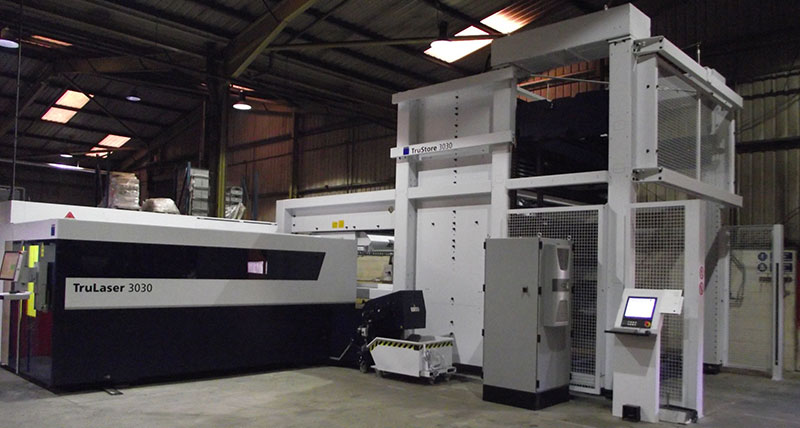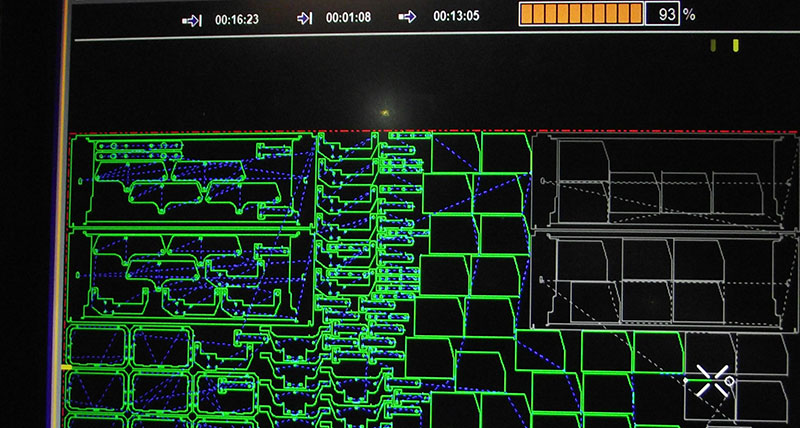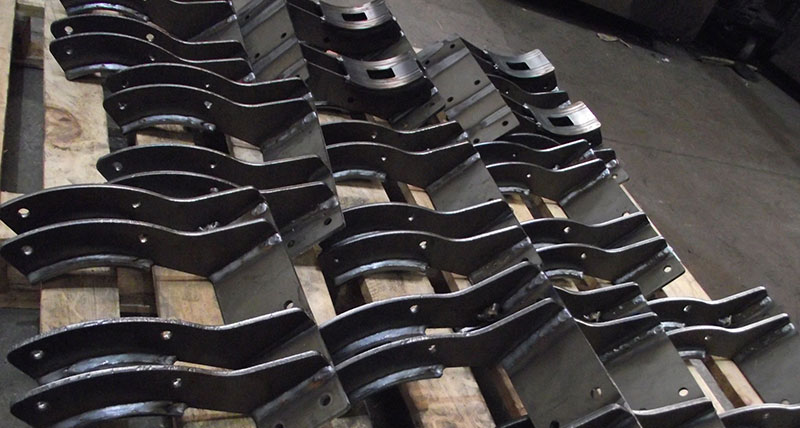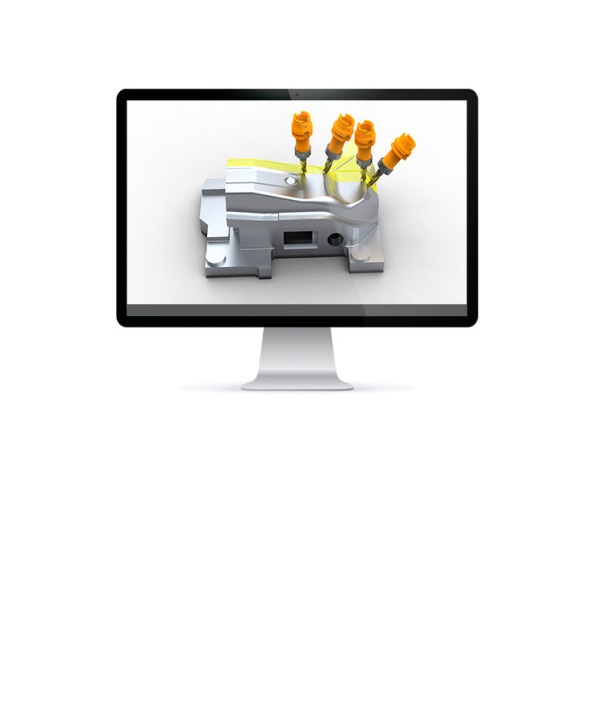RADAN intelligent nesting vital for Norlec
Norlec - UK
Contact us

One of the UK’s largest sheet metal subcontractors says the Project Nesting function in the world’s most powerful sheet metal CAD/CAM software, RADAN, is essential for keeping the company competitive.
And John Haworth, Managing Director of Norlec, says it is also a vital aspect of their manufacturing flexibility.
 “Customers want shorter lead times and smaller batch quantities, so our days of big production runs and nesting the same components on one full sheet are long gone. Thanks to the intelligent nesting in
RADAN
we’re constantly able to nest different components from a variety of customers on one sheet.”
“Customers want shorter lead times and smaller batch quantities, so our days of big production runs and nesting the same components on one full sheet are long gone. Thanks to the intelligent nesting in
RADAN
we’re constantly able to nest different components from a variety of customers on one sheet.”
Serving a large number of industrial sectors – yellow goods, heating, shopfitting and electrical switchgear being just a few – components and finished products vary in size and complexity, and include simple brackets, radiator covers and telephone housings, through to welded assemblies such as engine housings for trains, and fabricated assemblies for machines and off-road vehicles.
“It’s so easy with RADAN nests to fit small parts on to sheets of much larger components, which means we’re getting more than 80 per cent sheet utilisation instead of around 60 or 70 per cent which we were getting before.”
As well as flexibility, he says maximising sheet utilisation is also an important financial consideration, as steel prices are rising. “The more efficient we are with steel usage the better, because we pass that cost saving on to customers, making us much more competitive.”
The company, operating out of 50,000 square foot premises in Leyland in Lancashire, have recently added to their array of laser cutters, punch presses and press brakes, with the arrival of a Trumpf 3030 4kw fibre laser and fully automatic sheet stacker which can work with 33 tonnes of steel, unmanned, overnight and at weekends.
While the maximum number of sheets that can be used in the stacker depends on their thickness, the system has 11 pallets, each of which can carry three tonnes of steel. “It also removes the parts once they’ve been cut, and puts them back into the storage trays.”
He says they invested in the fibre laser because it cuts thinner gauge material faster than conventional lasers, and most of their metal is 5 mm or less. At the other end of the scale it will cut up to 25 mm thicknesses, along with copper and brass which, previously, they always had to punch. They have also installed a Nitrogen generator, as he says cutting with Nitrogen improves the painting process further along their production line.
And as RADAN drives all their CNC machine tools, John Haworth says they also instructed RADAN engineers to draw up the post processor for the new laser. “Having RADAN post processors for all our machines is ideal, as it means we only need to have one kind of symbol for a part – we don’t need to change multiple symbols, and can simply send the code to a punch press or a laser.”
He says that overall, RADAN helps them overcome their biggest challenge, which he says is the speed required from the time the product is ordered, through to completing manufacture and shipping it out to the customer. “From receiving an order, we can process it and have it in work literally within a few hours. Without RADAN it would take several days, or even weeks, particularly with complex parts.”
That point is seconded by Norlec’s Support Engineer Dave Sharratt, who says the company receives drawings or symbols either as a DXF file or PDF from the customer. “We use RADAN's unfolding method to produce our own flat blank or RADAN symbol, which is then saved within the RADAN system with all the symbols we need for current or future jobs. We look ahead to see what jobs are coming up, and then put all the parts into the project. It doesn’t matter what type of steel or what gauge it is, because Project Nesting separates it all out – then we set the project running, and the nester takes all the symbols and puts all of them into an appropriate nest, automatically taking into account the shape, material and gauge.”
The job can then be programmed for any of the punch presses or lasers.
RADAN's process management module, e2i, is used as their route system throughout the factory, with all instructions required to make a part managed by it. And he says e2i is even better since Works Order Nesting (WON) was introduced.
“Once we issue the route card we can run the WON system, telling it what we need to produce, bring in the required steel by gauge – but not specifically link the symbol to the gauge as the Project Nester handles that automatically – then when it’s nested we put it on whichever tool file we want. After that we create what we call ‘super route cards,’ which enable us to work with just one spec sheet which divides the runtime between the parts on the nest, instead of having to book numerous route cards on the system.
“And we can also use super route on common gauge parts that need folding. Again, it saves on booking time, because, if, for example, we’re bending three small brackets, we can just use one spec sheet, rather than create three individual spec sheets.”
And John Haworth, Managing Director of Norlec, says it is also a vital aspect of their manufacturing flexibility.
 “Customers want shorter lead times and smaller batch quantities, so our days of big production runs and nesting the same components on one full sheet are long gone. Thanks to the intelligent nesting in
RADAN
we’re constantly able to nest different components from a variety of customers on one sheet.”
“Customers want shorter lead times and smaller batch quantities, so our days of big production runs and nesting the same components on one full sheet are long gone. Thanks to the intelligent nesting in
RADAN
we’re constantly able to nest different components from a variety of customers on one sheet.”Serving a large number of industrial sectors – yellow goods, heating, shopfitting and electrical switchgear being just a few – components and finished products vary in size and complexity, and include simple brackets, radiator covers and telephone housings, through to welded assemblies such as engine housings for trains, and fabricated assemblies for machines and off-road vehicles.
“It’s so easy with RADAN nests to fit small parts on to sheets of much larger components, which means we’re getting more than 80 per cent sheet utilisation instead of around 60 or 70 per cent which we were getting before.”
As well as flexibility, he says maximising sheet utilisation is also an important financial consideration, as steel prices are rising. “The more efficient we are with steel usage the better, because we pass that cost saving on to customers, making us much more competitive.”
The company, operating out of 50,000 square foot premises in Leyland in Lancashire, have recently added to their array of laser cutters, punch presses and press brakes, with the arrival of a Trumpf 3030 4kw fibre laser and fully automatic sheet stacker which can work with 33 tonnes of steel, unmanned, overnight and at weekends.
While the maximum number of sheets that can be used in the stacker depends on their thickness, the system has 11 pallets, each of which can carry three tonnes of steel. “It also removes the parts once they’ve been cut, and puts them back into the storage trays.”
He says they invested in the fibre laser because it cuts thinner gauge material faster than conventional lasers, and most of their metal is 5 mm or less. At the other end of the scale it will cut up to 25 mm thicknesses, along with copper and brass which, previously, they always had to punch. They have also installed a Nitrogen generator, as he says cutting with Nitrogen improves the painting process further along their production line.
And as RADAN drives all their CNC machine tools, John Haworth says they also instructed RADAN engineers to draw up the post processor for the new laser. “Having RADAN post processors for all our machines is ideal, as it means we only need to have one kind of symbol for a part – we don’t need to change multiple symbols, and can simply send the code to a punch press or a laser.”
He says that overall, RADAN helps them overcome their biggest challenge, which he says is the speed required from the time the product is ordered, through to completing manufacture and shipping it out to the customer. “From receiving an order, we can process it and have it in work literally within a few hours. Without RADAN it would take several days, or even weeks, particularly with complex parts.”
That point is seconded by Norlec’s Support Engineer Dave Sharratt, who says the company receives drawings or symbols either as a DXF file or PDF from the customer. “We use RADAN's unfolding method to produce our own flat blank or RADAN symbol, which is then saved within the RADAN system with all the symbols we need for current or future jobs. We look ahead to see what jobs are coming up, and then put all the parts into the project. It doesn’t matter what type of steel or what gauge it is, because Project Nesting separates it all out – then we set the project running, and the nester takes all the symbols and puts all of them into an appropriate nest, automatically taking into account the shape, material and gauge.”
The job can then be programmed for any of the punch presses or lasers.

RADAN's process management module, e2i, is used as their route system throughout the factory, with all instructions required to make a part managed by it. And he says e2i is even better since Works Order Nesting (WON) was introduced.
“Once we issue the route card we can run the WON system, telling it what we need to produce, bring in the required steel by gauge – but not specifically link the symbol to the gauge as the Project Nester handles that automatically – then when it’s nested we put it on whichever tool file we want. After that we create what we call ‘super route cards,’ which enable us to work with just one spec sheet which divides the runtime between the parts on the nest, instead of having to book numerous route cards on the system.
“And we can also use super route on common gauge parts that need folding. Again, it saves on booking time, because, if, for example, we’re bending three small brackets, we can just use one spec sheet, rather than create three individual spec sheets.”
